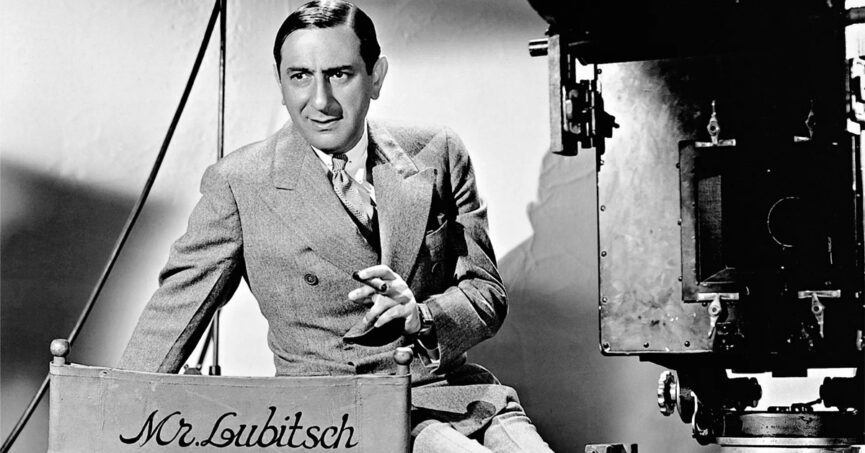Let’s talk about one of my all-time favorites: Ernst Lubitsch — the man with the famous “Lubitsch Touch.” If you don’t know what that means yet, don’t worry, I didn’t always either. But once you spot it, you see it everywhere: cleverness, subtlety, elegance, and a wink to the audience that says, “Hey, you’re smart. You can put this together.”
Ernst Lubitsch was the king of romantic comedies long before the term was cool — his films feel light and frothy on the surface, but underneath they’re layered with sly jokes and human truth. That’s the Touch: making it all look effortless.
Subtle, Clever, and Always a Step Ahead
Billy Wilder, who worshipped Lubitsch, famously kept a sign above his writing desk that simply read: “How would Lubitsch do it?” Wilder knew — and if you want to tell a good story, you should ask the same.
Take Trouble in Paradise (1932). It’s about two thieves who fall in love while stealing from a wealthy perfume magnate. Sounds scandalous, right? But Lubitsch doesn’t hit you over the head with dirty jokes — he dances around it, letting the audience read between the lines. When Gaston and Lily flirt, they do it with pickpocket banter that’s more romantic than a thousand sunset monologues.

LILY I like you, Baron. GASTON (fervently) I'm crazy about you. (He reaches in his side pocket, takes out a diamond brooch which Lily wore when she came in.) By the way, your pin. Lily is flabbergasted. She looks down to her bosom. Indeed, the pin is missing. She accepts the pin. LILY (With a little smile of shame) Thank you, Baron. GASTON Not at all, Countess ... There's one very good stone in it. LILY (as she fastens the pin) What time is it? Gaston reaches for his watch, discovers it is missing. He gives Lily a look of admiration and astonishment. Lily smiles triumphantly, opens her purse, lifts out the watch, hands it to him. He takes it with a bow. LILY It was five minutes slow, but I regulated it for you. They bow to each other like two Chinese mandarins. GASTON (tenderly) I hope you don't mind if I keep your garter. Lily almost leaps out of her chair. She raises her skirt; her hand searches for the garter. It is missing. Gaston takes the garter out of his breast pocket, shows it to her, kisses it, puts it back, and buttons his coat. Lily is delighted. This is the highest compliment ever paid to her. She slides into his lap, embraces him. LILY Darling! (They kiss; very excitedly.) Now tell me--tell me all about yourself. Who are you? GASTON You remember the man who walked into the Bank of Constantinople and walked out with the Bank of Constantinople? LILY (thrilled) Monescu! GASTON Gaston Monescu. LILY (melting away) Gaston! They embrace and kiss again.
Or look at Ninotchka (1939). This was Greta Garbo’s first comedy — and it works because of Lubitsch’s deft touch. He takes a cold, stern Soviet envoy and lets her slowly thaw into laughter and love. One of the film’s best lines isn’t even delivered with a wink — it’s all in the staging. “Garbo laughs!” was the tagline. The idea that an actress known for drama could surprise you with humor? That’s the Lubitsch Touch at work.
And don’t get me started on The Shop Around the Corner (1940). This is one of the greatest romantic comedies ever made! So good it’s been remade a dozen times (You’ve Got Mail, anyone?). It’s sweet, witty, and brimming with moments that trust the audience to connect the dots. When you see James Stewart’s face as he realizes who his pen pal is, Lubitsch lets the reaction play out naturally. No dramatic music swell, just pure, human magic.
How Lubitsch Inspired Generations
The “Lubitsch Touch” didn’t just inspire Billy Wilder — it rippled through generations. Directors like Wilder, Preston Sturges, Blake Edwards, Nora Ephron, and even modern rom-com writers owe him big time. The idea that a love story can be sophisticated and hilarious? That’s Lubitsch. The idea that the audience wants to feel clever — and doesn’t need every detail spoon-fed? That’s Lubitsch too.
Billy Wilder once said it best:
“He could do more with a closed door than other directors could do with an open fly.”
That one line sums up everything Lubitsch believed — suggestion over shock, subtlety over cheap laughs. Let the audience fill in the blanks.
When Wilder made Some Like It Hot, you can see Lubitsch’s fingerprints all over it. The sly innuendo, the layers of disguise, the humor that trusts the audience to keep up. Ephron’s When Harry Met Sally? That’s the Lubitsch Touch reimagined for a new generation — sharp, witty, and never insulting your intelligence.
How Lubitsch Influenced Mel Brooks (And My Fanboy Moment)

Now, I’m not bragging — okay, maybe I am — but let me fanboy for a second. I had the chance to meet Mel Brooks a few times over the years. The first time I met him, I just had to ask about Ernst Lubitsch. I couldn’t help myself. If you’re going to talk about wit, subtlety, and the art of letting the audience fill in the blanks, you have to talk about Lubitsch. And so does Mel Brooks I learned, we talked for over 30 minutes on this topic.
Obviously, you can see the Lubitsch Touch in Brooks’ own remake of To Be or Not to Be (1983). The original (1942) is a classic Lubitsch comedy about a Polish theater troupe caught up in Nazi-occupied Warsaw. heavy subject matter, but Lubitsch makes it biting, irreverent, and sly instead of bleak. Brooks’ version keeps that spirit: it’s a war satire that dances between absurdity and real stakes without ever feeling mean-spirited.
But Mel didn’t stop there. Watch The Producers or Blazing Saddles — you see the same DNA. He breaks the fourth wall, trusts the audience to catch layered jokes, and uses suggestion and double meaning just like Lubitsch did. His movies always feel like he’s whispering, “You’re in on this, right?” That wink is straight out of the Lubitsch playbook.
Talking to Mel Brooks about Ernst Lubitsch was one of those moments that made my inner writer want to high-five my 12-year-old filmmaker self. If Mel Brooks — the king of fearless, outrageous comedy — credits Lubitsch for showing him how to balance elegance and hilarity, then the rest of us better pay attention too.
50 Years Later Mel Still Appreciates It
The last time I saw Mel Brooks was at the fiftieth anniversary screening of Blazing Saddles. It kicked off with the audience howling through every second of this half-century-old masterpiece, while Mel waited backstage, listening to the laughter. When he came out, he said how happy he was that we still catch the subtle jokes, the ones you don’t see coming.
One of my favorites is in the villain lineup scene. Hedley Lamarr is recruiting the worst scoundrels he can find, and unknowingly is talking to Sheriff Black Bart. It’s broad and outrageous, but there’s this sly little exchange buried in the chaos:
HL: “Qualifications?”
BB: “Stampeding cattle.”
HL: “That’s not much.”
BB: “Through the Vatican?”
HL: “Kinky! Sign here.”
It’s a perfect example of that Lubitsch influence — irreverent, layered, and so quick you feel clever for catching it. No neon sign telling you “this is the joke.” Just a wink, a whisper: You get it, right?
What the Lubitsch Touch Means for Us Today
So why should you care about Ernst Lubitsch in the 21st century? Because when everyone is telling you to make things louder, bigger, faster, sometimes it pays to make your audience lean in instead of sit back.
I’ve been writing a lot of kids’ content these last few years, and the norm for children’s comedy is to explain everything. But I believe kids are smarter than most people think. I love letting them connect the dots and watching their faces light up when it works.
When I write a comedy sketch or a longer script, I always remind myself: “Would Lubitsch have shown that outright — or let the audience fill in the blanks?” Sometimes the joke that isn’t spelled out is the one that sticks.
So next time you’re watching your favorite rom-com, or writing one of your own, channel the spirit of Lubitsch: be clever, be subtle, and remember — the audience loves to add up two plus two.
Keep the Touch Alive
Billy Wilder had his sign — “How would Lubitsch do it?” Maybe you should have one too. I know I do, right next to my Oscar the Grouch, rubber chicken, and a stack of Lubitsch Blu-rays.
Watch Trouble in Paradise. Then watch Ninotchka. Watch The Shop Around the Corner. Then go make something that trusts your audience to be in on the joke.
That’s the Lubitsch Touch — and it’s timeless.

